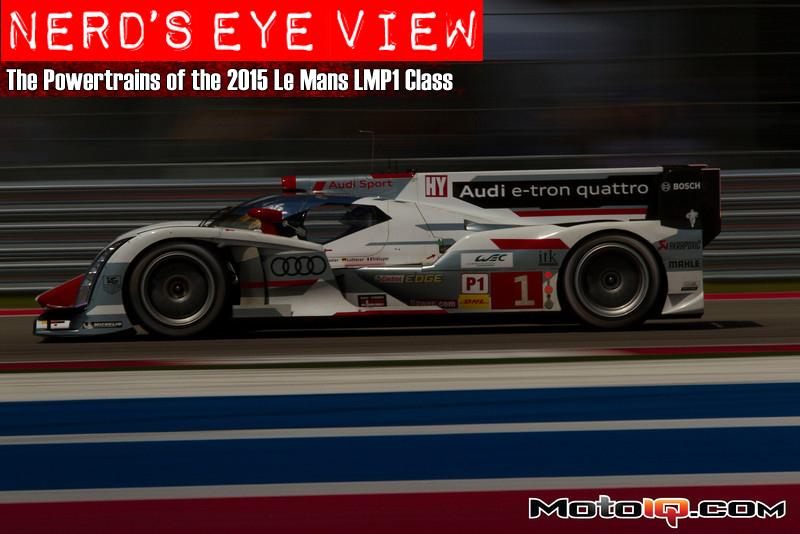,
 Similar to Audi, Porsche uses only a front MGU-K which also makes the car AWD. The effectiveness of AWD is readily apparent in the various comparisons between the Porsche 918 street car and the McLaren P1. The McLaren P1 makes more power and also has less mass to move around, yet the 918 has beaten it on a number of road courses as the AWD system allows the 918 to more effectively put power down vs. the RWD McLaren P1. Anyway, back to the race cars, Porsche differentiates itself from both Audi and Porsche by storing electrical energy by chemical means in the form of a lithium ion battery. Batteries have better energy density than capacitors, but batteries also have slower charge and discharge rates. Like I said, there’s always a compromise. (Photo from Porsche)
Similar to Audi, Porsche uses only a front MGU-K which also makes the car AWD. The effectiveness of AWD is readily apparent in the various comparisons between the Porsche 918 street car and the McLaren P1. The McLaren P1 makes more power and also has less mass to move around, yet the 918 has beaten it on a number of road courses as the AWD system allows the 918 to more effectively put power down vs. the RWD McLaren P1. Anyway, back to the race cars, Porsche differentiates itself from both Audi and Porsche by storing electrical energy by chemical means in the form of a lithium ion battery. Batteries have better energy density than capacitors, but batteries also have slower charge and discharge rates. Like I said, there’s always a compromise. (Photo from Porsche) Where Porsche is ground-breaking compared to Audi and Toyota is at the middle of the car. Porsche opted to go with a 2.0L gasoline-fueled turbocharged V4 engine. I wonder if Audi (and therefore sister company Porsche) having bought Ducati a few years ago aided in the engine development…. Anyway, Porsche deciding to go with a V4 engine instead of an inline-4 gives them the shortest engine package. Also ground-breaking, and unique in motorsports as far as I know, is the MGU-H (heat) used on the V4 engine. Typically, turbochargers on gasoline engines require a wastegate to control boost levels; if excess exhaust gas were not wastegated around the turbine wheel, the turbo would just spin faster until either the engine or turbo blew up. Typically, that exhaust gas that is wastegated is just, well, wasted. Porsche decided to put a little turbine in the wastegate flow to generate electricity recapturing some of the energy that would otherwise be lost. It’s not readily apparent in this mock-up photo, but the MGU-H uses a VNT (variable nozzle turbine) to optimize its performance for all engine operating conditions. (Photo from Porsche)
Where Porsche is ground-breaking compared to Audi and Toyota is at the middle of the car. Porsche opted to go with a 2.0L gasoline-fueled turbocharged V4 engine. I wonder if Audi (and therefore sister company Porsche) having bought Ducati a few years ago aided in the engine development…. Anyway, Porsche deciding to go with a V4 engine instead of an inline-4 gives them the shortest engine package. Also ground-breaking, and unique in motorsports as far as I know, is the MGU-H (heat) used on the V4 engine. Typically, turbochargers on gasoline engines require a wastegate to control boost levels; if excess exhaust gas were not wastegated around the turbine wheel, the turbo would just spin faster until either the engine or turbo blew up. Typically, that exhaust gas that is wastegated is just, well, wasted. Porsche decided to put a little turbine in the wastegate flow to generate electricity recapturing some of the energy that would otherwise be lost. It’s not readily apparent in this mock-up photo, but the MGU-H uses a VNT (variable nozzle turbine) to optimize its performance for all engine operating conditions. (Photo from Porsche)
 These two views show the overall layout of the Porsche powertrain. Compared to the Audi and Toyota, you can see just how short the engine package is in the middle of the car. I think this provides an aero benefit by allowing the rear bodywork to begin narrowing sooner and therefore helps with drag reduction and downforce generation. Why doesn’t everyone use a V4 if it’s so short providing an aero benefit? Well, a V4 engine configuration is not inherently well balanced. In fact, Porsche had a number of failures in the car from the vibrations of the engine. The engine has been thoroughly reworked for 2015 with a new firing order and crank among other things. (Photo from Porsche)
These two views show the overall layout of the Porsche powertrain. Compared to the Audi and Toyota, you can see just how short the engine package is in the middle of the car. I think this provides an aero benefit by allowing the rear bodywork to begin narrowing sooner and therefore helps with drag reduction and downforce generation. Why doesn’t everyone use a V4 if it’s so short providing an aero benefit? Well, a V4 engine configuration is not inherently well balanced. In fact, Porsche had a number of failures in the car from the vibrations of the engine. The engine has been thoroughly reworked for 2015 with a new firing order and crank among other things. (Photo from Porsche) I found this picture on the Internet somewhere but I don’t know who originally took it and I think it is from the 2014 car. Anyways, here you can see the turbocharger angled similar to the setup on the Audi. By being angled, the compressor inlet of the turbo has a straight shot into the air box which has the gold reflective tape on it. For 2015, there is some trickery going on with the turbo. According to an interview of Porsche published in the June issue of Racecar Engineering, the turbine geometry and compressor geometry are different so as to reduce the inertia of those rotating parts. Only time will tell what that means. Go read the June issue of Racecar Engineering, it’s good stuff.
I found this picture on the Internet somewhere but I don’t know who originally took it and I think it is from the 2014 car. Anyways, here you can see the turbocharger angled similar to the setup on the Audi. By being angled, the compressor inlet of the turbo has a straight shot into the air box which has the gold reflective tape on it. For 2015, there is some trickery going on with the turbo. According to an interview of Porsche published in the June issue of Racecar Engineering, the turbine geometry and compressor geometry are different so as to reduce the inertia of those rotating parts. Only time will tell what that means. Go read the June issue of Racecar Engineering, it’s good stuff. The car sending the LMP world spinning (and all of motorsport for that matter) is the Nissan entry. Nissan has enjoyed going against the grain recently with the DeltaWing and Zeod. Foregoing all conventional wisdom, Nissan placed the engine in the front of its LMP chassis. Why did they do that? It’s all about the aero at Le Mans. (Photo from Nissan)
The car sending the LMP world spinning (and all of motorsport for that matter) is the Nissan entry. Nissan has enjoyed going against the grain recently with the DeltaWing and Zeod. Foregoing all conventional wisdom, Nissan placed the engine in the front of its LMP chassis. Why did they do that? It’s all about the aero at Le Mans. (Photo from Nissan)


